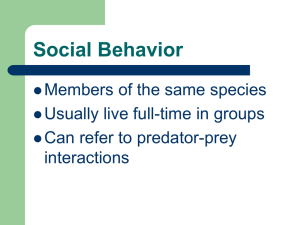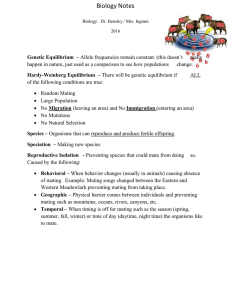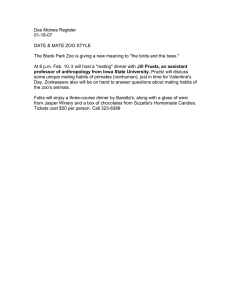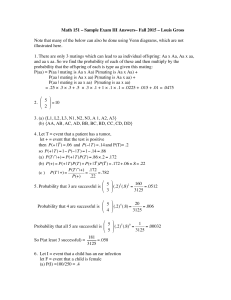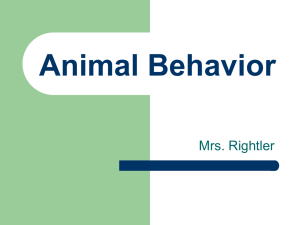this PDF file - Florida Online Journals
advertisement
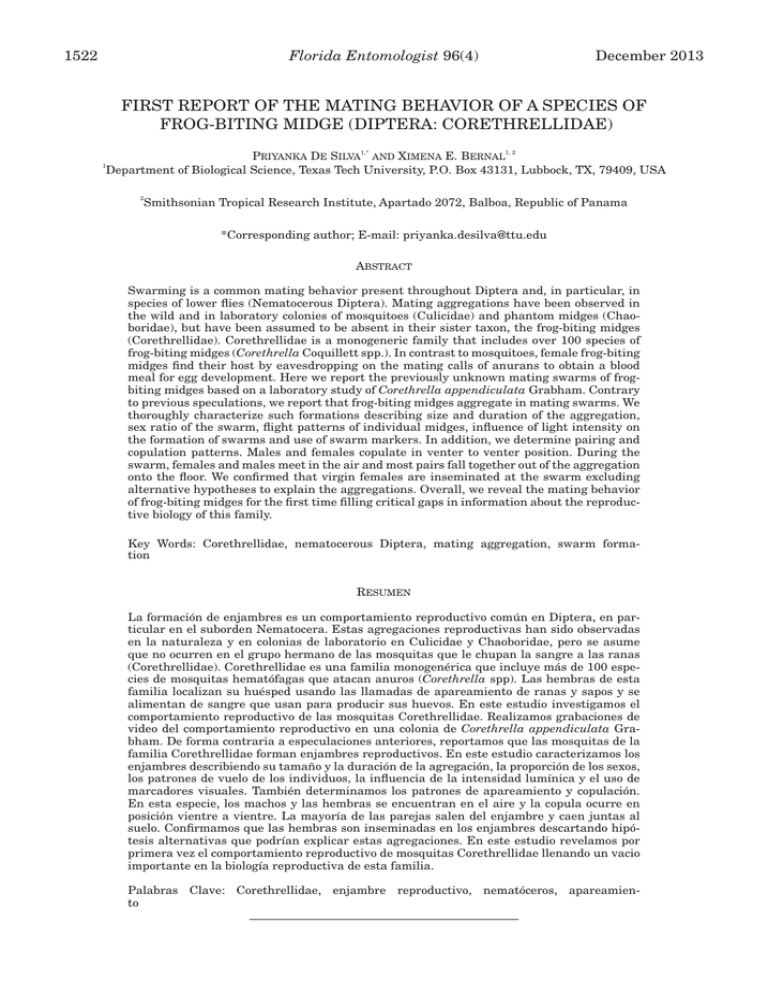
1522 Florida Entomologist 96(4) December 2013 First report of the mating behavior of a species of frog-biting midge (Diptera: Corethrellidae) 1 Priyanka De Silva1,* and Ximena E. Bernal1, 2 Department of Biological Science, Texas Tech University, P.O. Box 43131, Lubbock, TX, 79409, USA 2 Smithsonian Tropical Research Institute, Apartado 2072, Balboa, Republic of Panama *Corresponding author; E-mail: priyanka.desilva@ttu.edu Abstract Swarming is a common mating behavior present throughout Diptera and, in particular, in species of lower flies (Nematocerous Diptera). Mating aggregations have been observed in the wild and in laboratory colonies of mosquitoes (Culicidae) and phantom midges (Chaoboridae), but have been assumed to be absent in their sister taxon, the frog-biting midges (Corethrellidae). Corethrellidae is a monogeneric family that includes over 100 species of frog-biting midges (Corethrella Coquillett spp.). In contrast to mosquitoes, female frog-biting midges find their host by eavesdropping on the mating calls of anurans to obtain a blood meal for egg development. Here we report the previously unknown mating swarms of frogbiting midges based on a laboratory study of Corethrella appendiculata Grabham. Contrary to previous speculations, we report that frog-biting midges aggregate in mating swarms. We thoroughly characterize such formations describing size and duration of the aggregation, sex ratio of the swarm, flight patterns of individual midges, influence of light intensity on the formation of swarms and use of swarm markers. In addition, we determine pairing and copulation patterns. Males and females copulate in venter to venter position. During the swarm, females and males meet in the air and most pairs fall together out of the aggregation onto the floor. We confirmed that virgin females are inseminated at the swarm excluding alternative hypotheses to explain the aggregations. Overall, we reveal the mating behavior of frog-biting midges for the first time filling critical gaps in information about the reproductive biology of this family. Key Words: Corethrellidae, nematocerous Diptera, mating aggregation, swarm formation Resumen La formación de enjambres es un comportamiento reproductivo común en Diptera, en particular en el suborden Nematocera. Estas agregaciones reproductivas han sido observadas en la naturaleza y en colonias de laboratorio en Culicidae y Chaoboridae, pero se asume que no ocurren en el grupo hermano de las mosquitas que le chupan la sangre a las ranas (Corethrellidae). Corethrellidae es una familia monogenérica que incluye más de 100 especies de mosquitas hematófagas que atacan anuros (Corethrella spp). Las hembras de esta familia localizan su huésped usando las llamadas de apareamiento de ranas y sapos y se alimentan de sangre que usan para producir sus huevos. En este estudio investigamos el comportamiento reproductivo de las mosquitas Corethrellidae. Realizamos grabaciones de video del comportamiento reproductivo en una colonia de Corethrella appendiculata Grabham. De forma contraria a especulaciones anteriores, reportamos que las mosquitas de la familia Corethrellidae forman enjambres reproductivos. En este estudio caracterizamos los enjambres describiendo su tamaño y la duración de la agregación, la proporción de los sexos, los patrones de vuelo de los individuos, la influencia de la intensidad lumínica y el uso de marcadores visuales. También determinamos los patrones de apareamiento y copulación. En esta especie, los machos y las hembras se encuentran en el aire y la copula ocurre en posición vientre a vientre. La mayoría de las parejas salen del enjambre y caen juntas al suelo. Confirmamos que las hembras son inseminadas en los enjambres descartando hipótesis alternativas que podrían explicar estas agregaciones. En este estudio revelamos por primera vez el comportamiento reproductivo de mosquitas Corethrellidae llenando un vacio importante en la biología reproductiva de esta familia. Palabras Clave: Corethrellidae, enjambre reproductivo, nematóceros, apareamiento de Silva & Bernal: Mating Behavior of Frog-Biting Midges The mating behavior of given species is a unique, dynamic suite of interactions between the sexes. Several factors including ecological conditions prevailing in an animal’s habitat and the animal’s behavioral attributes determine the characteristics of the mating behavior of a given species (Emlen & Oring 1977; Thornhill et al. 1983). Understanding the mating behavior of a species is particularly important because it reflects the result of natural selection on mate choice, and ultimately on strategies for maximizing individual reproductive success. One of the major challenges encountered by sexually reproducing organisms is finding an individual of the opposite sex to court and ultimately mate. One strategy that has evolved to solve this problem is that members of one sex, usually the males, aggregate in a particular area to which the opposite sex is attracted. Such male aggregations are widespread across taxonomic groups and have been described in vertebrates (birds: Lill 1974; mammals: Bradbury & Vehrencamp 1977; amphibians: Arak 1983; fish: McKaye et al. 1990) and invertebrate species (insects: Snead & Alcock 1985; reviewed in Höglund & Alatalo 1995; Shuster & Wade 2003). Within insects, Diptera are different from most other insects in their mating behavior because of their ability to mate aerially, in swarms (reviewed by Downes 1969). Males of aerial swarming Diptera usually gather in discrete dancing swarms that use visual cues or landmarks as markers in the environment to determine swarm location (Nielsen et al. 1960; Downes 1969; Sullivan 1981; Blackwell et al. 1992; Clements 1999). Such swarms are seen in infraorders of nematocerous Diptera. In the Culicomorpha, of which Corethrellidae is a member family, aerial mating swarms are known for many species of Ceratopogonidae (Downes 1955; Downes 1958; Campbell & Kettle 1979; Zimmerman et al. 1982; Blackwell et al. 1992), Chaoboridae (Parma 1971; Moore 1986; Irvine 2000), Chironomidae (Gibson 1945; Young 1969; Oliver 1971; Paasivirta 1972; Kon 1987; Fyodorova & Azovsky 2003), Culicidae (Horsfall 1955; Nielsen et al. 1960; Downes 1969; Reisen et al. 1977; Clements 1999), and Simuliidae (Moorhouse & Colbo 1973; Hunter 1979). Such swarms are often found at characteristic sites, presumably guided by a visual marker (Marchand 1984; Yuval & Bouskila 1993; Charlwood et al. 2002). Although there is ample knowledge about the mating behavior of most species of Culicomorpha, no studies have investigated the mating and swarming behavior of Corethrellidae (frog-biting midges). This monogeneric family (Corethrellidae, Diptera) is an ancient group of small eavesdropping flies (oldest fossils are 122 million years old), which includes over 100 described species (Borkent 2008; Borkent & Grafe 2012). Frogbiting midges, are the sister taxon to phantom 1523 midges (Chaoboridae) + true mosquitoes (Culicidae) (Borkent 1989). Females of most species of the Corethrellidae are haematophagous and feed on anuran blood to obtain protein for egg development (Williams & Edman 1968; McKeever 1977; McKeever & French 1991). Some, at least, are facultatively autogenous and one species from Australia has reduced mouthparts and is, therefore, fully autogenous. Different from most other haematophagous insects, however, female Corethrella use the mating calls of male anurans to find their hosts (McKeever 1977; Bernal et al. 2006; Borkent 2008; Grafe et al 2008). No information is known, however, about the mating behaviors of species in this group. Although it has been suggested that no mating swarms are formed in this family (Borkent 2008; Yuval & Bouskila 1993), no critical investigation has been pursued to date. In this study we investigate the mating behavior of laboratory reared Corethrella appendiculata Grabham to address the following questions: (i) does this species form aerial swarms during mating? (ii) what are the characteristics of mating swarms? and, (iii) what cues are used to initiate mating swarms? To our knowledge this study is the first attempt to investigate the mating behavior of frog-biting midges. We provide novel information about the reproductive biology of frog-biting-midges, a group receiving recent increased attention in recent years (Bernal et al. 2006; Borkent 2008; Borkent & Grafe 2012; de Silva et al in review). Materials and Methods Study Species We obtained frog-biting midges from the C. appendiculata colony maintained at Texas Tech University, Lubbock, Texas (Bernal Lab, Department of Biological Sciences). Corethrella appendiculata is facultatively haematophagous and thus females do not require a blood meal to lay their first batch of eggs. An initial batch of larvae to initiate the colony was obtained from Phil Lounibos at the University of Florida and reared to adulthood. Larvae were reared in white plastic trays (34.3 × 25.4 × 3.8 cm) filled with 800 mL distilled water. Developing larvae were kept in low densities (50 larvae per tray) and fed with live nematodes (Panagrellus redivivus L.; Rhabditida: Panagrolaimidae) twice a week following the methods described by Haramis & Foster (1983) to produce nearly synchronized emergence of uniformly-sized adults. Pupae were collected from the larval trays into clear vials and transferred to holding cages (BioQuip lightweight aluminum collapsible cages; 46 × 46 × 46 cm; 2 × 2mm mesh size) for adult emergence. Adults were reared at 27 ± 1 °C, 70-80% RH, and 10:14 h L:D. Midge 1524 Florida Entomologist 96(4) cages were kept inside an environmental chamber (Power Scientific Inc, model DROS28SSD, LEVEL 2) where adults were provided continuous access to 10% sucrose solution from wicks. Mating Behavior of the Midges We used a four-camera infrared video system (Zmodo PKD-DK4216-500GB H.264) to monitor the behavior of the midges in the frog-biting midge colony. The activities of the midges were video recorded 24 h/day for 1 month to examine their mating behavior (7 Jun-7 Jul 2012). We characterized the mating swarms of frog-biting midges by analyzing their aggregations and flight pattern. We also examined the influence of light intensity on swarm formation. To do so, we gradually changed the light intensity inside the environmental chamber. The light intensity level was changed from standard colony light conditions (185 lx) to darkness in 5 steps : (i) 185 lx (darkest storm clouds midday), (ii) 67 lx (family living room light), (iii) 31 lx (fully overcast sunset), (iv) 2 lx (moon light), and (v) 0 lx (complete darkness) (Schlyter 2006; Pears 1998). At each light level, the light conditions were maintained constant for 12 min using a light transformer dimmer (Lutron Skylark Contour Dimmers). Light intensity levels inside the experimental cage were measured with a universal exposure meter (Extech LT300). Observations were made during this experiment at the standard time at which lights were progressively changed in the colony (1730 h-1830 h). Preliminary investigations revealed that changing the initial time at which light intensity decreases in the colony across a variety of times (1430-1530, 1530-1630, 1630-1730, 1730-1830 and 1830-1930 h) does not affect the behavior of the midges. All the video recordings were analyzed, 1 h at a time, to describe the behavior of the midges over the course of 1 month. We analyzed a total of 31 swarm formations. The midges formed mating aggregations, but only one each night. For each swarm, we report the aggregation pattern of the midges, the beginning and ending time of the aggregation, the duration of the aggregation and the effect of light intensity level on the aggregation behavior of midges. The number of male and female midges at the beginning (10 min), middle (25 min) and the end (50 min) of the aggregation was determined using samples of individuals obtained from a swarm with a mechanical aspirator (Hausherrs Machine Works, New Jersey). We obtained samples from 6 swarms, collecting a total of 1,236 individuals that were sexed to calculate the number of males and females during swarm formation. In addition, we set up and video recorded small swarms (around 20 individuals) to examine individual flight patterns in more detail. We then, analyzed the flight pattern of individual midges by tracking the flight paths frame December 2013 by frame during 2 s intervals drawing the path directly from a computer monitor (Dell Precision T3500). We used a camcorder (Sony DCR-SR-220) to video record the swarms through a Plexiglas wall under red light to observe and quantify pairing and copulation. To determine insemination while swarming, we separated 200 male and 200 female pupae and reared these in 2 separate rearing cages (20 × 20 × 20 cm; 2 × 2 mm mesh size). The experiment was set up with 10 small rearing cages (10 × 10 × 10 cm) each with fifteen 1-day old virgin males. Two of the experimental cages were monitored to observe the age at which males initiated swarming in the absence of females. Fifteen oneday old virgin females were introduced to 1 cage and monitored for pairing to determine the age at which they start mating. On the fifth day, fifteen five-day old virgin females were added to each of the remaining experimental cages (n = 7). Detailed observations of the swarm were performed in 5 of those 7 experimental cages. Immediately after the swarm ended, the females from each cage were transferred to 70% alcohol to dissect their spermathecae and determine the insemination rate (n = 75 females). The 2 remaining experimental cages were continuously observed for swarming and after 4 consecutive nights, we dissected 30 females to determine the percentage of individuals inseminated after 4 swarms. These experiments to examine the insemination rate of females in the swarms ultimately exclude alternative explanations for the formation of the aggregations (e.g., feeding aggregations, increased activity). Results Our results revealed swarm formation in a species of Corethrellidae, C. appendiculata. The aggregation was initiated by 1-2 midges flying in small elliptical circles in the same area. Within 10-15 min the swarm became dense with more midges joining it and reached its maximum size at about 25 min. Swarm size was estimated to be between 15 and over 800 individuals at its maximum. After 40-55 min of continuous swarming, males stopped flying and most males rested on the cage floor. The flight patterns of individuals within the swarms followed elliptical trajectories in a helix-like pattern (Fig. 1). At the beginning of the swarm individuals flew following small elliptical paths in a single plane. As the swarm progressed, they formed larger ellipses and moved faster following a helical pattern to the bottom of the swarm and circle back up again. The midges paused briefly at the top of the swarm and then flew in a spiral down again. Each spiral down from the top to the bottom of the swarm was completed by an individual in about 2 s. When swarming, individuals flew with their antennal de Silva & Bernal: Mating Behavior of Frog-Biting Midges 1525 Fig. 2. Swarm formation under different light intensities. Light intensities:185 lx (darkest storm clouds midday), 67 lx (family living room light), 31 lx (fully overcast sunset), 2 lx (moon light), and 0 lx (complete darkness). N = 8 trials for each light intensity. Fig. 1. Flight path of a representative Corethrella appendiculata midge in a swarm during about 2 s. (a) View from above (b) View from the side. Stars indicate the midge’s position while the arrows indicate its direction of midges as they fly up and down the spiral. fibrillae erect. At the end of the swarm, however, the individuals landed on the ground with their antennal fibrillae decumbent. When kept under a natural 10:14 dark: light cycle, C. appendiculata formed male aggregations exclusively under low light conditions (Fig. 2). The swarm was initiated soon after the chamber lights were turned off and the light intensity in their cage was 2 lx or less. Also, the swarm loosened and quickly disappeared when the light intensity of the cage gradually increased above 2 lx. A single mating aggregation was formed each night. Sometimes, after the main aggregation was discontinued, a few midges flew for a few minutes in a swarming pattern but the aggregation dissolved before reaching high densities. Extending daytime light conditions into the hours at which the swarms usually formed prevented swarm formation. Corethrella appendiculata used visual markers for swarm formation. In 74% of the cases the swarm was initiated over the black circular sugar wick (23 out of 31 observed swarms).The swarm was initiated close to the ground (2-3 cm from the sugar wick). As the swarming progressed, however, the midges spread throughout the whole cage. When the sugar wick was moved randomly inside the cage, in 100% of the cases male midges initi- ated the swarm over the newly positioned swarm marker (n = 8). The aggregations were formed mainly by males with an increasing number of females as the swarm progresses (t-test, df = 5, P < 0.001; Fig. 3). At the beginning of the swarm, 99% of the individuals were males. The proportion of females increased from 1 to 5% from the beginning to the end of the swarm. It was not possible to see the arrival of females to the swarm but pairs in copula first appeared at about 20 min after Fig. 3. Number of males (gray) and females (black) in the swarm near the beginning (10 min), middle (25 min) and end (50 min) from the start of mating pair formation. T-tests, df = 5,* denotes P < 0.001. 1526 Florida Entomologist 96(4) the initiation of the swarm. In each swarm, the number of pairings rapidly increased to reach a maximum within 40-55 min (Fig. 4). Mating pairs of C. appendiculata were commonly observed falling out of swarms onto the floor of the cage. In the 6 swarms we investigated in detail, we observed the formation of 430 total pairs (72 ± 11 pairs per swarm, n = 6). About 47% of the pairs continued to copulate for a few seconds after falling onto the ground (17.3 ± 5.6 sec, n = 34 pairs). Pairs copulated in venter to venter position (12 ± 2 pairs observed, n = 6 swarms). Copulation took about 24.9 ± 5.5 s (n = 12 pairs). Pairing, however, was hard to distinguish in the dense swarm and the actual copulation time is probably slightly higher than recorded here. Experiments with 15 virgin males revealed that they start participating in swarms within 2 days of emergence (n = 2 swarms). In the cage with 1-day old females, however, coupling only took place 4 days after emergence (n = 1 swarm). The insemination rate of 5-day old virgin females during a single swarming opportunity was 30% (23 out of 75 females inseminated, n = 5 swarms). The insemination rate, however, increased tremendously as females participated in additional swarms. We observed that 80% of virgin females were inseminated after swarming on 4 consecutive nights (24 out of 30 females, n = 2 swarms). Discussion In general, our results revealed and characterized the formation of mating aggregations in C. appendiculata under laboratory conditions. Clements (1999) defines mating swarms in mosqui- Fig. 4. Temporal distribution of male-female pairs of Corethrella appendiculata during mating swarms (n = 6 swarms). December 2013 toes as aggregations with the following characteristics: (i) individuals flying within a limited space located in relation to some feature of the environment and individuals following a looping or zigzagging pattern characteristic of the species, (ii) the swarms consisting predominantly of males, and, (iii) swarming is limited to times of the day characteristic of the species, usually close to dusk or dawn. Our results provide evidence that the mating swarms of C. appendiculata are consistent with Clements (1999) definition of such aggregations in mosquitoes. Based on the presence of 2 C. cretacea males preserved in close proximity in amber, Borkent (2008) suggested ancestral lineages in this group may had formed mating swarms. Given the limited evidence of this behavior in extant Corethrella species, however, Borkent (2008) concluded that this behavior may be now absent. Contrary to previous predictions suggesting lack of swarm formation in Corethrellidae (Yuval & Bouskila 1993; Borkent 2008), we report strong evidence revealing the formation of mating swarms in frogbiting midges as described below. In C. appendiculata the flight pattern during swarming has similar characteristic elements as those described for most swarming insects (reviewed in Clements 1999; Sullivan 1981), including persistent flight pattern, formalized movements (elliptical trajectories in a helical pattern) and restriction to a certain space. Similarly, size and duration of the swarm as well as when it is formed are consistent with the general characteristics described for mating swarms in other dipterans (Nielsen & Haeger 1960; Charlwood et al. 1980; Reisen et al. 1985). In general, swarm formation in dipterans occurs at sunset under low light conditions (0-2 lx) along areas of female flight activity given their biting habits (Downes 1969; Nielsen & Nielsen 1962). We observed that C. appendiculata aggregate in mating swarms shortly after the light intensity has decreased below 2 lx, i.e., light conditions consistent with the time of the day when females initiate feeding. In agreement with reports for other Culicomorpha where swarms are commonly formed over conspicuous visual markers (Downes 1969; reviewed in Clements 1999), our results suggest C. appendiculata likely also use visual markers to initiate their swarms. Corethrella appendiculata form mating aggregations in almost complete darkness similar to those of some anopheline mosquitoes which do the same (Charlwood & Jones 1980; Reisen et al. 1985; McDaniel 1986; Charlwood, 2003). Land et al. (1999) reported that the eyes of anophelines are extremely sensitive to low light levels equivalent to nocturnal light conditions. It is possible that C. appendiculata also have a visual system that allows them to use visual markers to form aggregations under low light conditions. Although chemical cues de Silva & Bernal: Mating Behavior of Frog-Biting Midges could also potentially be used in swarm formation, the limited use of pheromones in this context in mosquitoes (Takken & Knols 1999) suggests that semiochemicals are unlikely to be involved. Corethrella appendiculata swarm formation is elicited by the onset of a dark photophase and visual cues (landmarks) that are likely involved in determining the location of where the swarm is formed. As in the colony, males in nature probably fly and aggregate near the ground in damp moist areas. We suggest that in the wild mating swarms of frog-biting midges are formed around small water pools that might be habitats for anurans. Such swarms might not have been noticed in the field before due to the small size of the midges, the proximity of the aggregation to the water surface and the crepuscular or nocturnal aggregating behavior similar to that of most other Culicomorpha. Mating swarms result from sexual selection favoring a lek-like system (Bradbury & Davies, 1987; reviewed in Clements 1999). As proposed for other culicid species (Yuval & Bouskila 1993), the male-biased sex ratio and increased number of females as the swarm progresses strongly suggest the mating aggregations of C. appendiculata also act as a lek system. Accordingly, in the swarms of C. appendiculata a small proportion of males mate while almost all females achieve a mating. We observed high number of pairs formed towards the end of the swarms (last 15 min). Around 30% of the virgin females were inseminated during a single swarming event. This insemination rate is comparable to the rate described for a laboratory colony of Aedes communis (McDaniel 1986). Not surprisingly, we observed that multiple swarms increased the insemination rate of females. Around 80% of the females were inseminated after 4 consecutive swarming nights. This higher rate is also comparable to the insemination rate of Ae. communis after mating swarm events (70%; McDaniel 1986). The finding that virgin females are inseminated during swarming is robust evidence that swarm formation in this species occurs in a mating context. It is unknown how Corethrellidae midges communicate while swarming. Acoustic signals, however, are likely to be involved. Sound is used in mating interactions in many species of Culicidae (reviewed in Gibson 1985; Clements 1999; Cator 2010), which together with Chaoboridae form the sister group of frog-biting midges (Borkent 2008). Male mosquitoes have more elaborate antennae than females that are involved in the detection of the wing beats of conspecific mates and play a critical role in courtship behavior (reviewed in Clements 1999; Hart et al. 2010). The pronounced sexual dimorphism of the antenna of C. appendiculata (Bernal et al. unpublished data) is reminiscent of such differences between the sexes in mosquitoes and strongly suggests acoustic sig- 1527 nals are also used in Corethrellidae in a mating context. In addition, across several Diptera species there is an association between erect antennal hairs in males while swarming and the use of flight tones to identify conspecific females (Roth 1948; reviewed in Clements 1999). Similarly to most swarming mosquitoes (Charlwood & Jones 1980; Clements 1999), we found that almost all male C. appendiculata swarm with their antennal fibrillae erect. Further research that directly examines the use of acoustic mating signals, however, is necessary to confirm that sound is used in the swarming of frog-biting midges. We are currently investigating antennal hearing and the communication system of frog-biting midges during swarming to explore the use of sound in mating in this family. Our results discovered the mating behavior of frog-biting midges, thereby filling a large gap in information about the reproductive biology and mating behavior of a family of Culicomorpha group. The current results also demonstrate the importance of swarm formation in the mating behavior of C. appendiculata. This contribution to the current knowledge about the mating behavior in this family provides basic information required to understand the evolution of such mating strategies. Finally this study provides an impetus to explore the use of sound in mating behavior in these midges. Acknowledgments We are thankful to Phil Lounibos, University of Florida, for providing larvae to initiate the frog-biting midge colony at Texas Tech University. We are also grateful to Art Borkent (Salmon Arm, BC, Canada) and an additional anonymous reviewer who provided valuable comments to improve this manuscript. This work was supported by the National Science Foundation (NSF) grant IOS-1258039 to X.E.B. References Cited Arak, A. 1983. Male-male competition and mate choice in anuran amphibians Mate choice. Cambridge University Press, Cambridge. Bernal, X. E., Rand, A. S., and Ryan, M. J. 2006. Acoustic preferences and localization performance of blood-sucking flies (Corethrella Coquillett) to tungara frog calls. Behav. Ecol. 17: 709-715. Blackwell, A., Mordue, A. J., Young, M. R., and Mordue, W. 1992. The swarming behavior of the scottish biting midge, Culicoides impunctatus (Diptera, Ceratopogonidae). Ecol. Entomol. 17: 319-325. Borkent, A. 2008. The frog-biting midges of the world (Corethrellidae: Diptera). Zootaxa: 1-456. Borkent, A., and Craig, D. A. 2004. Austroconops Wirth and Lee, a lower cretaceous genus of biting midges yet living in western Australia: a new species, first description of the immatures and discussion of their biology and phylogeny (Diptera : Ceratopogonidae). American Mus. Novit. 3449: 1-67 1528 Florida Entomologist 96(4) Borkent, A., and Grafe, T. U. 2012. The frog-biting midges of Borneo-from two to eleven species (Corethrellidae: Diptera). Zootaxa: 1-45. Borkent, A. 2012. The pupae of Culicomorpha-morphology and a new phylogenetic tree. Zootaxa 3396: 1-98. Bradbury, J. W., and Verhrencamp, S. L. 1977. Social organization and foraging in emballonurid bats. Behav. Ecol. Sociobiol. 2: 1-17. Bradbury, J. W., and Davies, N. B.1987. Relative roles of intra-and intersexual selection, pp. 143-163 In J. W. Bradbury and M. B. andersson [eds.], Sexual Selection: Testing the Alternatives. John Wiley & Sons, Chichester. Campbell, M. M., and Kettle, D. S. 1979. Swarming of Culicoides Brevitarsis kieffer (Diptera: Ceratopogonidae) with reference to markers, swarm size, proximity of cattle, and weather. Australian. J. Zool. 27: 17-30. Cator, L. J., Arthur, B. J., Harrington, L. C., and Hoy, R. R. 2009. Harmonic convergence in the love songs of the dengue vector mosquito. Science 323: 1077-1079. Charlwood, J. D., and Jones, M. D. R.1980. Mating in the mosquito, Anopheles gambiae sl. Physiol. Entomol. 5: 315-320. Charlwood, J. D., Pinto, J., Sousa, C. A., Madsen, H., Ferreira, C. D. o., and Rosario, V. E. 2002. The swarming and mating behaviour of Anopheles gambiae ss (Diptera: Culicidae) from Sao Tome Island. J. Vect. Ecol. 27: 178-183. Charlwood, J. D., Thompson, R., and Madsen, H. 2003. Observations on the swarming and mating behaviour of Anopheles funestus from southern Mozambique. Malaria J. 2: 1-10. Clements, A. N. 1999. The biology of mosquitoes; Sensory reception and behaviour. CABI Publishing Wallingford, Oxon. Downes, J. A. 1955. Observations on the swarming flight and mating of Culicoides (Diptera: Ceratopogonidae). Trans. R. Entomol. Soc. London 106: 213-236. Downes, J. A. 1958. The feeding habits of biting flies and their significance in classification. Annu. Rev. Entomol. 3: 249-266. Downes, J. A. 1969. The swarming and mating flight of Diptera. Annu. Rev. Entomol. 14: 271-298. Emlen, S. T., and Oring, L. W. 1977. Ecology, sexual selection, and the evolution of mating systems. Science 197: 215-223. Fyodorova, M. V., and Azovsky, A. I. 2003. Interactions between swarming Chironomus annularius (Diptera: Chironomidae) males: role of acoustic behavior. J. Insect Behav. 16: 295-306. Gibson, N. H. E. 1945. On the mating swarms of certain Chironomidae (Diptera). Trans. R. Entomol. Soc. London 95: 263-294. Gibson, G. 1985.Swarming behavior of the mosquito Culex pipiens quinquefasciatus: a quantitative analysis. Physiol. Entomol. 10: 283-296. Grafe, T. U., Saat, M., Binti, H., Hagen, N., Kaluza, B., Berudin, H., and Bin M. A. 2008. Acoustic localization of frog hosts by blood sucking flies Corethrella Coquillet (Diptera:Corethrellidae) in Borneo. Australian J. Entomol. 47: 350-354 Haramis, L. D., and Foster, W. A. 1983. Survival and population density of Aedes triseriatus (Diptera: Cu- December 2013 licidae) in a woodlot in central Ohio , USA. J. Med. Entomol. 20: 391-398. Hart, M., Belton, P., and Gries, G. 2010. The effect of fibril erection on hearing in male Aedes togoi: an open and shut case. Canadian Acoust. 38: 36-37. Höglund, J., and Alatalo, R. V. 1995. Leks. Princeton University Press. Horsfall, W. E. 1955. Mosquitoes. Their Bionomics and Relation to Disease. Ronald Press Co., New York. Hunter, D. M. 1979. Swarming, mating and resting behaviour of three species of black fly (Diptera: Simuliidae). Australian J. Entomol. 18: 1-6. Irvine, K. 2000. Macrodistribution, swarming behaviour and production estimates of the lakefly Chaoborus edulis (Diptera: Chaoboridae) in Lake Malawi, pp. 431-448 In A. Rossiter and H. Kawanabe [eds.], Advances in Ecological Research. Academic Press, Kraus, J. D. 1966. Radio Astronomy. McGraw-Hill, New York. Kon, M. 1987. The mating system of chironomid midges (Diptera: Chironomidae). Memmoirs of the Faculty of Science, Koyoto University. Series of Biology 12: 129-134. Lill, A. m. 1974. Social organization and space utilization in the lek-forming white-bearded manakin, M. manacus trinitatis Hartert. Zeitschrift für Tierpsychologie 36: 513-530. Land, M. F., Gibson, G., Horwood, J., and Zeil, J. 1999. Fundamental differences in the optical structure of the eyes of nocturnal and diurnal mosquitoes. J. Comp. Physiol.185: 91-103. Marchand, R. P. 1984. Field observations on swarming and mating in Anopheles gambiae mosquitoes in Tanzania. Netherlands J. Zool. 34: 367-387. McDaniel, I. N. 1986. Swarming and mating of univoltine Aedes mosquitoes in the laboratory. J. American Mosquito Control Assoc. 2: 321. McKaye, K. R., Louda, S. M., and Stauer, J. R. 1990. Bower size and male reproductive success in a cichlid fish lek. American Nat. 135: 597-613. McKeever, S. 1977. Observations of Corethrella feeding on tree frogs (Hyla). Mosquito News 37: 522-523. McKeever, S., and French, F. E. 1991. Corethrella (Diptera, Corethrellidae) of eastern North-America -Laboratory life history and field responses to anuran calls. Ann. Entomol. Soc. America 84: 493-497. Moore, M. V. 1986. Method for culturing the phantom midge, Chaoborus (Diptera: Chaoboridae), in the laboratory. Aquaculture 56: 307-316. Moorhouse, D. E., and Colbo, M. H. 1973. On the swarming of Austrosimulium pestilens MacKerras and MacKerras (Diptera: Simuliidae). Australian J. Entomol. 12: 127-130. Nielsen, E. T., Haeger, J. S, and Bell, R. T. 1960. Swarming and mating in mosquitoes. Entomol. Soc. America Misc. Publ. 1: 71-95. Nielsen, H. T., and Nielsen, E. T. 1962. Swarming of mosquitoes. Laboratory experiments under controlled conditions. Entomol. Exp. Appl. 5: 14-32. Oliver, D. R. 1971. Life history of the Chironomidae. Annu. Rev. Entomol. 16: 211-230. Paasivirta, L. 1972. Taxonomy, ecology and swarming behaviour of Tanytarsus gracilentus Holmgr. (Diptera, Chironomidae) in Valassaaret, Gulf of Bothnia, Finland. Ann. Zool. Fennici 9: 255-264. de Silva & Bernal: Mating Behavior of Frog-Biting Midges Parma, S. 1971. Chaoborus flavicans (Meigen)(Diptera, Chaoboridae), an autecological study. Univ. Groningen, Groningen. 128 pp. Pears, A. 1998. Strategic study of household energy and greenhouse issues, pp. 61-63 In Sustainable Solutions, Australia. Reisen, W. K., Aslam, Y., and Siddiqui, T. F. 1977. Observations on the swarming and mating of some Pakistan mosquitoes in nature. Ann. Entomol. Soc. America 70: 988-995. Reisen, W. K., Knop, N. F., and Peloquin, J. J. 1985. Swarming and mating behavior of laboratory and field strains of Culex tarsalis (Diptera: Culicidae). Ann. Entomol. Soc. America 78: 667-673. Roth, L. M. 1948. A study of mosquito behavior. An experimental laboratory study of the sexual behavior of Aedes aegypti (Linnaeus). American Midl. Nat. 40: 265-352. Schlyter , P. 2006. Radiometry and photometry in astronomy FAQ In Stockholm, Paul Schlyter Home Page. http://stjarnhimlen. se/comp/radfaq. html Shuster, S. M., and Wade, M. J. 2003. Mating systems and strategies. Princeton University Press. 1529 Snead, J. S., and Alcock, J. 1985. Aggregation formation and assortative mating in two meloid beetles. Evolution 39: 1123-1131. Sullivan, R. T. 1981. Insect swarming and mating. Florida Entomol. 64: 44-65. Takken, W., and Knols, B. G. 1999. Odor-mediated behavior of Afrotropical malaria mosquitoes. Annu. Rev. Entomol. 44: 131-157. Thornhill, R., Dodson, G., and Marshall, L. 1983. Sexual selection and insect mating behavior. American Biol. Teach. 45: 310-319. Williams, J. A., and Edman, J. D. 1968. Occurrence of blood meals in two species of Corethrella in Florida. Ann. Entomol. Soc. America 61: 1336-1336. Young, R. M. 1969. Field observations on a midwinter breeding flight of Diamesa arctica (Diptera: Chironomidae). Ann. Entomol. Soc. America 6: 1204. Yuval, B., and Bouskila, A. 1993. Temporal dynamics of mating and predation in mosquito swarms. Oecologia 95: 65-69. Zimmerman, R. H., Barker, S. J., and Turner, E. C. 1982. Swarming and mating behavior of a natural population of Culicoides variipennis (Diptera: Ceratopogonidae). J. Med. Entomol. 19: 151-156.
